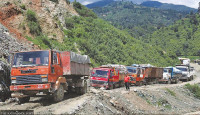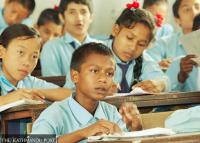Opinion
Revisiting the NGO numbers debate
There is nothing ‘overwhelming’ about the increase; if anything, it is a fact to celebrate, not condemn
Pratyoush Onta & Avash Bhandari
In early 2002, the then Nepal Government circulated a draft of what it called the “Policy Paper on Civil Society Partnership” as a discussion paper for a Pre-Consultation Meeting of the Nepal Development Forum—2002. In it, the government maintained that while the number of non-governmental organisations (NGOs) which had been legally registered with the 75 District Administration Offices (DAO) of Nepal was unknown, it estimated that there were upwards of 15,000 such entities. The same paper then went on to describe the growth in the number of NGOs since the end of the Panchayat system in 1990 as “overwhelming”.
Such sentiment has been repeated on countless occasions by government bureaucrats and commentators in Nepali media in the past 15 years. This has given a fillip to the ever-present populist anti-NGO rhetoric in Nepali public sphere about the “mushrooming” growth of NGOs. The growth of NGOs is seen by some as an evidence of the formation of a “parallel state”. Hence the NGO numbers debate needs a careful revisit for several reasons.
First, the people’s right to association is one of the fundamental rights guaranteed by the 2015 Constitution of Nepal as it was by the previous two—the 1990 and 2007—constitutions of Nepal. The rise of non governmental entities in Nepal should be seen in the light of the increasing democratisation and opening up of Nepali society following the success of the first Janandolan of 1990. It is important to relate NGOs to the democratisation process because essentially NGOs result from groups of people coming together, with certain objectives and purposes, to exercise their constitutional right to organise. According to Nepal’s law (Associations Registration Act, 1977), such entities then register at the DAO and are recognised as formal, legal NGOs. As a consequence of a rigid legal framework, all such civic organisations are put in a single category of NGOs no matter how different their objectives, work, and styles of operation might be. Seen in the light of Nepali citizens’ choice to exercise their fundamental right, there is nothing “overwhelming” about the increase in the number of NGOs. If anything, it is a fact to celebrate, not to condemn.
Different from Panchayat days
Second, the rise in NGO numbers since 1990 should remind us that the pre-1990 Panchayat system had cruelly and artificially forbidden Nepali citizens to organise in the form of associations of their choice. As we argued in an earlier op-ed (‘CSOs in a Loktantrik Nepal’, February 11, Page 6), the king-led Panchayat system was all encompassing and thrived on the notion that “all Nepalis are Panchas”. It instituted an entity headed by the then queen, Social Services National Coordination Council (SSNCC), to primarily control people’s initiatives in the name of “coordination” and “avoiding duplication”. SSNCC was the bureaucratic tool of the Panchayat system to colonise the entire terrain of civil society space in the name of “social service”.
In contrast, a democratic and loktantrik polity recognises the autonomy of civil society. Such polity is organised to acknowledge the independence of civil society organisations as a manifestation of the citizens’ fundamental rights to form associations and to their freedom of thought and expression. If it were not so, there would be no point mentioning these freedoms along with a long list of other fundamental rights in the 2015 Constitution of Nepal. Therefore, if the significant growth in the number of NGOs can be timed to the end of that absolute king-led system, it is no coincidence. This increase should not give the government or anyone else who work for it much headache unless of course they are still thinking in “all Nepalis are Panchas” mode.
Third, no one knows the total number of NGOs that have been registered at the 75 DAOs. Among those registered, it is also not clear how many actually have a functional life as an organisation. Some sub-set of such registered entities, namely, those hoping to get non-Nepali financial assistance, have also registered themselves at the Social Welfare Council (SWC). According to SWC, as of July 2014, the total number of NGOs registered at the council is 39,759. For a generous thought experiment, let us assume that the total number of NGOs in Nepal is two and half times that number, namely, 100,000. Furthermore let us assume that on average, each NGO has 30 separate members. Working with these very generous assumptions, we end up with 3,000,000 individual citizens who might be associated with 100,000 separate NGOs in Nepal. Now, 30 lakhs or three million is about 10 percent of Nepal’s current population, hardly a number that substantiates the “mushrooming NGOs” or “parallel state” diagnosis. To the contrary, it suggests that only about 10 percent of Nepal’s citizens have thus far exercised their right to organise in the form of civic entities. If fundamental rights are for enjoying, then clearly many more NGOs need to be born nationwide.
Regional and thematic disparity
Fourth, while bemoaning the proliferation of NGOs, it is necessary to be clear that the spread of NGOs is not even all over Nepal. SWC lists 24,841 NGOs affiliated with it that work in the Central Development Region (CDR). On the other hand, there are only 3,417 and 2,551 NGOs in the Mid-Western and Far-Western Development Regions respectively. And when we examine where these NGOs are registered, their urban bias is evident. For example, in the Mid-Western Development Region, the largest number of NGOs is in Dang (595) whereas in the whole district of Dolpa, there are only 100 such entities. Similarly, in the Far-Western Development Region, most NGOs are centred in the Tarai district of Kailali (801) whereas the number is only 123 for Dadeldhura. These numbers are not surprising, but they are revealing. If fundamental rights are for enjoying by all citizens of Nepal, clearly citizens in these two regions need to be encouraged to form more, not less, civic society organisations.
Fifth, according to the SWC’s classification of NGOs in terms of work-thematic sectors, there are 25,403 NGOs working in “Community and Rural Development Services” sector. In contrast, there are only 517 NGOs under the category “Educational Development”, and there is not even a separate category for non-governmental entities working in the field of knowledge production (“academic NGOs”). Likewise, the number of NGOs under “Environmental Protection” category is only 1,451 and the number is a paltry 98 for “Aids and Abuse Control”. The answer to this mismatch is more non-governmental entities in sectors with fewer current numbers. For that to happen, one also needs to go beyond a simplistic conceptualisation of NGOs as service delivery and development “partners” in the mode adopted by the pre-1990 regime.
But then to really engage in the NGO numbers debate, one needs to recognise the importance of the idea of fundamental rights in a loktantrik polity. One also needs to have the confidence to say that the “control mentality” of the Panchayat System is not the appropriate way to think about a diverse civil society organisational landscape of today’s Nepal.
Bhandari and Onta are researchers at Martin Chautari, an academic NGO in Kathmandu




 23.12°C Kathmandu
23.12°C Kathmandu











